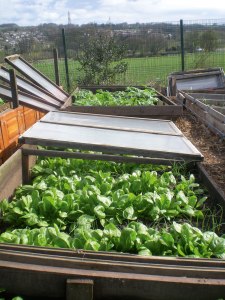
With winter finally closing in, thoughts of sowing vegetables in spring seem a long way off. We must wait until the soil warms up to the point which allows germination and growth to proceed. And when that time finally arrives we often oblige hungry snails who after a long hibernation find young tender salads on their doorstep.
Yet a solution to this predicament has been around for at least two thousand years. Hot beds are well documented in history, but have been forgotten in modern times. Now, gardeners are returning to this organic and sustainable practice to extend their growing season and keep fresh, local produce on their tables.
To be able to sow seeds in January or February makes perfect sense when one understands the advantages. Crops grown in winter and harvested as early as March are not subjected to the pests and diseases which plague summer crops. It is also possible to produce crops with little or no irrigation during this time. One makes use of valuable light early in the season that late starters have lost. These are a few but there are many more advantages. If you are planning a hot bed, then now is the perfect time to get started.

You will, when you make a hot bed, understand the simplicity of such a method and its workings. A hot bed releases heat over a period of a few months, or longer depending on size and height. Soil or compost placed on top is warmed as is the air which is contained in a shallow frame.
Horse manure was traditionally the main component in the construction of hot beds, as were other animal manures. Don’t be put off at this stage thinking that these materials are unobtainable in your area, for there are many alternatives that can be used. It is a shame to see the millions of tons of leaves blowing about the streets, all of which make up the bulk of countless hot beds, so gather what you can. I have also incorporated various old clothes made of cotton or wool, paper, cardboard, wood shavings, hessian sacks, feathers, shoddy. There is also seaweed to consider if you live by the coast and also straw.

Another tip for building up bulk is not to compost the usual garden and kitchen waste. If you have space then first wilt or dry these materials as best you can before placing them not in a compost bin but on pallets where sunshine and air can reach them. Keep rain off by some kind of roof of boards or iron sheets or similar. If possible, leave clippings from your last cut of the lawn on the ground to dry for a few days or longer before adding to the pile.
Drying these materials and keeping rain off will prevent the usual fast decomposition and heat that is produced when placed in a compost bin. Instead you will be left with the bulk for your hot bed and the potential release of heat when you require it. Look up any local stables in your area – some of them are waiting and willing to let you take away the end product. There are around one million horses ponies and donkeys in Britain, so there is a fair old pile out there!

There are of course more details and tips in my book Hot Beds: How to grow early crops using an age-old technique. This handy guide will take you through everything you need to know to start your own hot beds.
Get 30% off and free delivery in the UK for Hot Beds until the 2nd November 2014 by entering the voucher code ‘HotBeds2014’ when buying the book from greenbooks.co.uk.

Jack First is an experienced hot bed gardener and author. He uses this fantastic technique to grow crops throughout the year in Yorkshire. If you have any further questions, please don’t hesitate to contact him at jackfirstgrove@aol.com